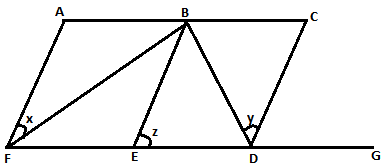9th Grade > Mathematics
QUADRILATERALS MCQs
Total Questions : 57
| Page 2 of 6 pages
Answer: Option C. -> diagonals of PQRS are perpendicular and bisect each other
:
C
Let ABCD be a rectangle such as AB = CD and BC = DA. P,Q,R and S are the midpoints of the sides AB, BC, CD and DA respectively.

Let us join AC and BD
In ΔABC,
P and Q are the mid-points of AB and BC respectively.
∴ PQ || AC and PQ = 12AC (Midpoint theorem)...........(1)
Similarly in Δ ADC,
SR || AC and SR=12AC (Midpoint theorem)..........(2)
Clearly, PQ || SR and PQ = SR
Since, in quadrilateral PQRS, one pair of opposite sideis equal and parallel to each other, it is parallelogram
∴ PS || QR and PS = QR (opposite sides of parallelogram).........(3)
In Δ BCD, Q and R are the mid-points of sides BC and CD respectively.
∴ QR || BD andQR=12BD(Midpoint theorem)..........(4)
However, the diagonals of a rectangle are equal.
∴ AC = BD ...........(5)
By using equation (1), (2), (3), (4), (5), we obtain
PQ = QR = SR = PS
Therefore, PQRS is a rhombus and hence, the given statement is true.
:
C
Let ABCD be a rectangle such as AB = CD and BC = DA. P,Q,R and S are the midpoints of the sides AB, BC, CD and DA respectively.

Let us join AC and BD
In ΔABC,
P and Q are the mid-points of AB and BC respectively.
∴ PQ || AC and PQ = 12AC (Midpoint theorem)...........(1)
Similarly in Δ ADC,
SR || AC and SR=12AC (Midpoint theorem)..........(2)
Clearly, PQ || SR and PQ = SR
Since, in quadrilateral PQRS, one pair of opposite sideis equal and parallel to each other, it is parallelogram
∴ PS || QR and PS = QR (opposite sides of parallelogram).........(3)
In Δ BCD, Q and R are the mid-points of sides BC and CD respectively.
∴ QR || BD andQR=12BD(Midpoint theorem)..........(4)
However, the diagonals of a rectangle are equal.
∴ AC = BD ...........(5)
By using equation (1), (2), (3), (4), (5), we obtain
PQ = QR = SR = PS
Therefore, PQRS is a rhombus and hence, the given statement is true.
Answer: Option B. -> False
:
B
In a trapezium only one pair of opposite sides areparallel.
Ina parallelogram, both pairs of opposite sides are equal and parallel.
Therefore a trapezium is not a parallelogram.
:
B
In a trapezium only one pair of opposite sides areparallel.
Ina parallelogram, both pairs of opposite sides are equal and parallel.
Therefore a trapezium is not a parallelogram.
:
By joining the mid points of the sides of a quadrilateral, another quadrilateral is formed whose opposite sides will be equal and parallel. Hence the quadrilateral formed is aparallelogram.
Answer: Option B. -> False
:
B
Sum of all angles of a quadrilateral is 360∘.
Fourthangle=360∘−(75∘+90∘+75∘)=120∘
Since the pairs of opposite angles of a parallelogram are equal, this quadrilateral cannot be a parallelogram since it has three different angles and only one pair of equal angles.
:
B
Sum of all angles of a quadrilateral is 360∘.
Fourthangle=360∘−(75∘+90∘+75∘)=120∘
Since the pairs of opposite angles of a parallelogram are equal, this quadrilateral cannot be a parallelogram since it has three different angles and only one pair of equal angles.
Answer: Option A. -> True
:
A
A parallelogram is a quadrilateral whose both pairs of opposite sides are equal and parallel. Since the pairs of opposite sides equal and parallel in a square, rhombus and rectangle,they are all parallelograms.
:
A
A parallelogram is a quadrilateral whose both pairs of opposite sides are equal and parallel. Since the pairs of opposite sides equal and parallel in a square, rhombus and rectangle,they are all parallelograms.
Answer: Option B. -> Circle
:
B
A quadrilateral is a polygon with four sides and four vertices.
A quadrilateral has four sides, four angles and four vertices. Square, trapezium and rhombus are quadrilaterals. A circle can be approximated as a polygon with infinite sides but it is not a polygon.
It is because a polygon must have straight edges (sides). A circle doesn't have straight sides.
:
B
A quadrilateral is a polygon with four sides and four vertices.
A quadrilateral has four sides, four angles and four vertices. Square, trapezium and rhombus are quadrilaterals. A circle can be approximated as a polygon with infinite sides but it is not a polygon.
It is because a polygon must have straight edges (sides). A circle doesn't have straight sides.
Answer: Option C. -> Parallelogram
:
C
A parallelogram is a quadrilateral whose both pairs of opposite sides are parallel.
:
C
A parallelogram is a quadrilateral whose both pairs of opposite sides are parallel.
Answer: Option B. -> 36∘, 72∘, 108∘, 144∘
:
B
Let the smallest angle of quadrilateral be x∘.
Then, the angles of the quadrilateral will be x∘, 2x∘, 3x∘ and4x∘.
Sum of the angles of a quadrilateral is 360∘.
⇒360∘=x+2x+3x+4x
⇒10x=360∘
∴x=36∘,2x=72∘,3x=108∘and4x=144∘
:
B
Let the smallest angle of quadrilateral be x∘.
Then, the angles of the quadrilateral will be x∘, 2x∘, 3x∘ and4x∘.
Sum of the angles of a quadrilateral is 360∘.
⇒360∘=x+2x+3x+4x
⇒10x=360∘
∴x=36∘,2x=72∘,3x=108∘and4x=144∘
















